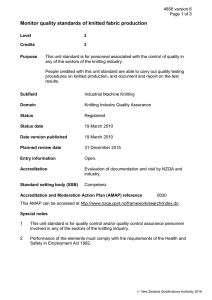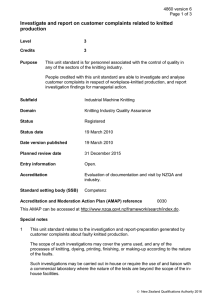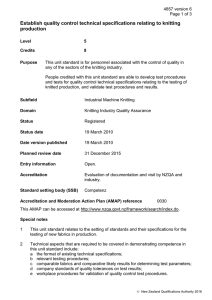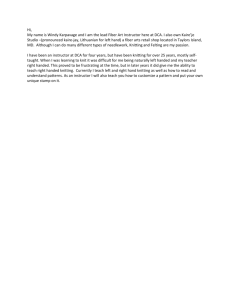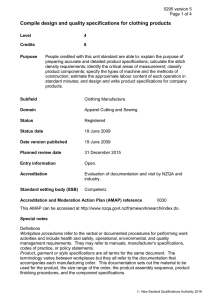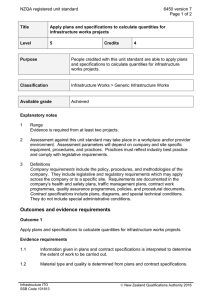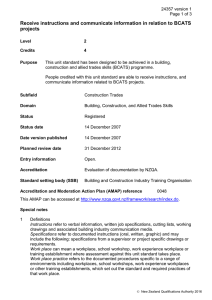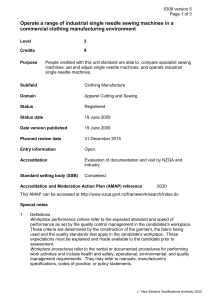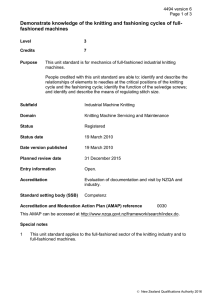Adjust machine settings and monitor and control knitting quality on
advertisement
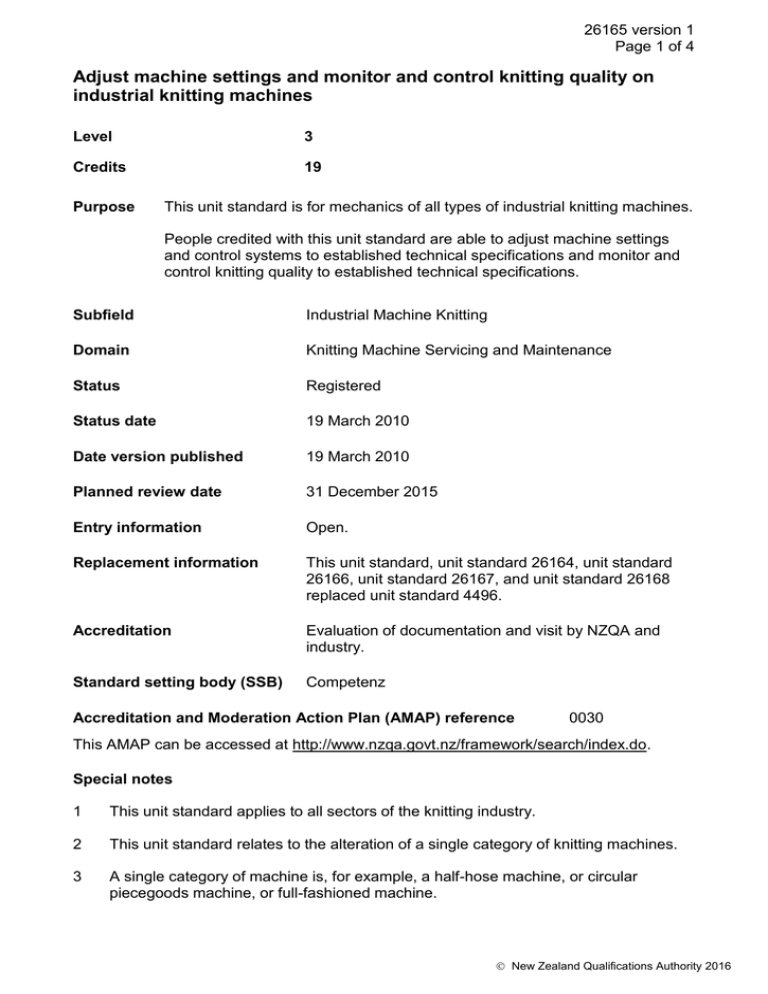
26165 version 1 Page 1 of 4 Adjust machine settings and monitor and control knitting quality on industrial knitting machines Level 3 Credits 19 Purpose This unit standard is for mechanics of all types of industrial knitting machines. People credited with this unit standard are able to adjust machine settings and control systems to established technical specifications and monitor and control knitting quality to established technical specifications. Subfield Industrial Machine Knitting Domain Knitting Machine Servicing and Maintenance Status Registered Status date 19 March 2010 Date version published 19 March 2010 Planned review date 31 December 2015 Entry information Open. Replacement information This unit standard, unit standard 26164, unit standard 26166, unit standard 26167, and unit standard 26168 replaced unit standard 4496. Accreditation Evaluation of documentation and visit by NZQA and industry. Standard setting body (SSB) Competenz Accreditation and Moderation Action Plan (AMAP) reference 0030 This AMAP can be accessed at http://www.nzqa.govt.nz/framework/search/index.do. Special notes 1 This unit standard applies to all sectors of the knitting industry. 2 This unit standard relates to the alteration of a single category of knitting machines. 3 A single category of machine is, for example, a half-hose machine, or circular piecegoods machine, or full-fashioned machine. New Zealand Qualifications Authority 2016 26165 version 1 Page 2 of 4 4 All alterations to machine settings must be carried out in accordance with workplace procedures, and as directed by a supervisor. 5 Performance of the elements must comply with the requirements of the Health and Safety in Employment Act 1992. 6 Technical aspects that are required to be covered in demonstrating competence in this unit standard may include any or all of the following, depending on the machines used in the workplace: a application of occupational safety and health procedures, including the use of first aid equipment and safe lifting practices; b the gauging system applying to the category of machines: i Tricot machines – needles per inch over one needle bar; ii Raschel machines – needles per 2 inches over one needle bar; iii hosiery machines – total number of needles in a single cylinder divided by 22/7 x machine diameter in inches; iv full-fashioned machines – needles per 1½ inches over one needle bar; v circular piecegoods and garment-length machines, flat bed machines – needles per one inch in one needle bed; vi other machines and gauging systems to be specified; c identification of all needles and elements used by the person by distinctions of: i identification numbers; ii gauge or thickness; iii butt positions and heights or lengths; iv latch motion or length; v hook or beard size; vi engineering features such as crimp, friction bend, left or right transfer cut-out; d the relationship between gauge and yarn count, fabric thickness, fabric weight, stitch density; e the use of engineering tools in the correct and fitting manner; f preparation to specifications or instructions of machine control systems, as appropriate, such as: i control chains; ii control drum(s); iii striping chains; iv pasteboard cards; v punched cards, or tapes; vi perforated tapes; g set-up and alteration of fabric quality mechanisms, as appropriate, such as: i take-up rollers and run-in (warp knitting); ii stitch cams and takedown rollers (weft knitting); iii dial height adjustment (on circular rib and interlock machines); iv yarn furnishing systems (weft knitting); v quality motion and slur cams (full-fashioned machines); vi quality measurement systems, which may include: stitch density; hosextender or extension device; volumetric measurement; fabric weight; vii other systems, as specified; New Zealand Qualifications Authority 2016 26165 version 1 Page 3 of 4 viii preparation to specifications or instructions of machine pattern-control systems which may include, as appropriate: pattern chains; pegged drums; breakable-bit pattern jacks or strips; pattern wheels, pattern discs, disc stacks, selector combs; steel cards; h lubricants and oiling schedules. 7 Definitions Technical specifications refer to material such as set-out diagrams or product specifications from either machine manufacturers or the workplace. Material maybe supplied in hard copy or in electronic form. Workplace procedures refer to the verbal or documented procedures for performing activities including health and safety, operational, environmental and quality management requirements. They refer to manuals, manufacturers’ specifications, codes of practice, or policy statements. Elements and performance criteria Element 1 Adjust machine settings and control systems to established technical specifications. Performance criteria 1.1 The knitting mechanisms are set to meet technical specifications. 1.2 The machine control systems are set to meet technical specifications. Element 2 Monitor and control knitting quality to established technical specifications. Performance criteria 2.1 Knitting quality is set to meet technical specifications. 2.2 Production is monitored, and adjustments are made to maintain technical specifications in accordance with workplace procedures. Please note Providers must be accredited by NZQA, or an inter-institutional body with delegated authority for quality assurance, before they can report credits from assessment against unit standards or deliver courses of study leading to that assessment. Industry Training Organisations must be accredited by NZQA before they can register credits from assessment against unit standards. Accredited providers and Industry Training Organisations assessing against unit standards must engage with the moderation system that applies to those standards. New Zealand Qualifications Authority 2016 26165 version 1 Page 4 of 4 Accreditation requirements and an outline of the moderation system that applies to this standard are outlined in the Accreditation and Moderation Action Plan (AMAP). The AMAP also includes useful information about special requirements for organisations wishing to develop education and training programmes, such as minimum qualifications for tutors and assessors, and special resource requirements. Comments on this unit standard Please contact Competenz info@competenz.org.nz if you wish to suggest changes to the content of this unit standard. New Zealand Qualifications Authority 2016
